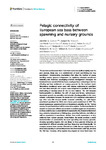Pelagic connectivity of European sea bass between spawning and nursery grounds
| dc.contributor.author | Graham, JA | |
| dc.contributor.author | Watson, JW | |
| dc.contributor.author | García García, LM | |
| dc.contributor.author | Bradley, K | |
| dc.contributor.author | Bradley, R | |
| dc.contributor.author | Brown, M | |
| dc.contributor.author | Ciotti, Benjamin | |
| dc.contributor.author | Goodwin, D | |
| dc.contributor.author | Nash, RDM | |
| dc.contributor.author | Roche, WK | |
| dc.contributor.author | Wogerbauer, C | |
| dc.contributor.author | Hyder, K | |
| dc.date.accessioned | 2023-02-14T11:28:59Z | |
| dc.date.available | 2023-02-14T11:28:59Z | |
| dc.date.issued | 2023-01-19 | |
| dc.identifier.issn | 2296-7745 | |
| dc.identifier.issn | 2296-7745 | |
| dc.identifier.uri | http://hdl.handle.net/10026.1/20345 | |
| dc.description.abstract |
<jats:p>The sea bass stock around the UK (northern stock) has declined rapidly over the past decade, likely due to a combination of both overfishing and low recruitment. Understanding mechanisms that drive the number of young reaching nursery grounds is important for explaining observed recruitment variability and therefore developing effective management strategies. An individual-based model (IBM) has been developed here to investigate factors affecting sea bass settlement on nursery grounds for the northern stock. Simulations considered seven years with varying environmental conditions and year class strength, and outputs were compared to empirical data from monitoring of nursery areas in the UK and Ireland. The IBM includes hydrodynamics to simulate the drift of eggs and larvae, temperature-dependent growth and mortality, and behavior affecting position in the water column. Comparison between the model and ICES assessment abundance of age class zero fish showed similar temporal variability, but with higher recruitment predicted for 2018, and a lower peak recruitment in 1997. The model reproduced general patterns of interannual variability for the Thames estuary, but performed less well for some other regions. Further investigation is needed to understand differences between modelled supply and observations, as these could be due to uncertainties in reproducing the physical environment (e.g., currents, temperature) or biology (e.g., spawning, behavior, mortality), as well as uncertainty in recruitment derived from stock assessments or data collected from nursery grounds. Nevertheless, the model provides a useful demonstration of connectivity between spawning and nursery grounds, showing spawning regions that are likely to have greatest influence on recruitment in different estuaries, and how these may vary interannually. For example, sources from western Channel and Celtic Sea can supply larvae to many areas, leading to connectivity across the Channel and Celtic Sea, and into the Irish Sea. However, other regions may depend on more local areas. For example, with the Solent estuary dependent on sources within the Channel each year. With the temperature-dependence on growth, and therefore duration of the pelagic stage, results show the potential influence of spawning timing, in relation to ocean temperatures, for connectivity between spawning and nursery grounds.</jats:p> | |
| dc.format.extent | 1046585- | |
| dc.language.iso | en | |
| dc.publisher | Frontiers Media | |
| dc.title | Pelagic connectivity of European sea bass between spawning and nursery grounds | |
| dc.type | journal-article | |
| dc.type | Journal Article | |
| plymouth.volume | 9 | |
| plymouth.publication-status | Published online | |
| plymouth.journal | Frontiers in Marine Science | |
| dc.identifier.doi | 10.3389/fmars.2022.1046585 | |
| plymouth.organisational-group | /Plymouth | |
| plymouth.organisational-group | /Plymouth/Faculty of Science and Engineering | |
| plymouth.organisational-group | /Plymouth/Faculty of Science and Engineering/School of Biological and Marine Sciences | |
| plymouth.organisational-group | /Plymouth/REF 2021 Researchers by UoA | |
| plymouth.organisational-group | /Plymouth/REF 2021 Researchers by UoA/UoA07 Earth Systems and Environmental Sciences | |
| plymouth.organisational-group | /Plymouth/Users by role | |
| plymouth.organisational-group | /Plymouth/Users by role/Academics | |
| dcterms.dateAccepted | 2022-12-12 | |
| dc.rights.embargodate | 2023-2-15 | |
| dc.identifier.eissn | 2296-7745 | |
| dc.rights.embargoperiod | Not known | |
| rioxxterms.versionofrecord | 10.3389/fmars.2022.1046585 | |
| rioxxterms.licenseref.uri | http://www.rioxx.net/licenses/all-rights-reserved | |
| rioxxterms.type | Journal Article/Review |


